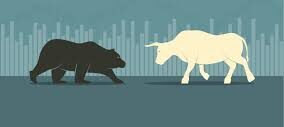Why can’t we say “up” or “down”? When describing the Stock Market, experts use the terms “Bull” and “Bear”. What are Bull and Bear Markets?
What does that actually mean?
Understanding Investing and the Stock Market is hard enough. Why add more terms that mean the same thing?
To my fellow Level Zero Investors, why do they do this to us?
I want to learn about investing my money into companies, but what do two animals have anything to do with it?
Keep reading below to help eliminate confusing animal investing terms of the Bull and Bear Markets.
Bull and Bear Markets
Basic Definition
“Bull” refers to an increase, a positive direction, or an upward movement.
Conversely,
“Bear” refers to a decrease, a negative direction, or a downward movement.
Why Animals?
Why on Earth did we choose these two animals?

Until I researched the answer to this question, the choice of these two animals made no sense to me.
Physical Appearance
When comparing their physical appearance, they look similar.
Both have four legs.
They are mammals.
Their average weight is similar.
Both have tails.
Both are very strong.
If physical appearance mattered in describing the Stock Market, maybe they should have chosen a giraffe for an increasing market or an ant for a decreasing market.
Clearly, appearance does not matter.
Direction of Attack
One correlation between their physical appearance and the direction of the Stock Market is the way they attack.

A Bull attacks with his horns. Picture a Matador. As they approach their target, the Bull lowers his head and thrust his horns upward.
A Bear attacks with his paws. When the Bear swipes at its opponent, it’s in a downward direction. Or they even stand up on their hind legs and then come down on their opponent.
Origin of these Terms
While the direction of their attacks provides a visual representation of a Market trend, I doubt that is where the origin of these animals came from. After doing some research, this is what I’ve determined.
Bear Origin
Long ago, people traded Bearskins. However, these traders often would sell the Bearskins at a certain price before they possessed the item.
Why sell something you don’t already own?
By “locking in” that price when you decided to sell it, these traders hoped that the price would be cheaper by the time they came into possession of the Bearskin.
Example
Monday – The Bearskin Trader found a buyer willing to pay $100.
Friday – 5 days later, the Bearskin Trader acquired the Bearskin. However, due to supply and demand, the Bearskin Trader only paid $80.
The Bearskin Trader made an extra $20 in this trade.
Another term for this is called “shorting”. This is a more advanced topic, which we can study at a later date, not a Level Zero topic.
For those already interested, there’s a good article on it here.
Bull Origin
There seems to be less historical evidence on the origin of Bull compared to our Bearskin Sellers.
Perhaps, since their physical characteristics are so similar, that is why they are lumped together.
One could conclude that if they look similar and a Bear would indicate a downward trend, the Bull must be the opposite, indicating an upward trend.
How to Use These Terms
Now that we have an idea of where these animal terms came from, how are these used?
Adjective
First off, we are taking two animals, and two nouns, and using them as adjectives. In essence, we can now describe anything as a Bear or Bull.
I can even describe the weather this way;
“Even though the weather has been miserable lately, I am Bullish on the weather turning around into a beautiful weekend.”
Now people don’t typically do that, because Bear-Bull is primarily used to describe Stock Market related things, but you get the idea.
Earlier on, I’d already described the Stock Market as a Bull or a Bear, but you can describe a stock, company, or industry as being a Bull or Bear.
When analyzing a company and you see strong financials, good leadership, a great moat (we’ll talk about moats later), or a generally positive outlook, one would say “I am Bullish about company XYZ.”
Emotion
The last thing I want to mention about how these terms are used is less scientific and more of an art and emotion.
When reading articles or watching the talking heads on TV, many times they will use Bear and Bull to convey emotions or sentiments.
There may be data or evidence to support their claim, but you could ask ten experts and receive ten different “feelings” on the matter.
Technical Definition of Bull and Bear Markets
To this point, I’ve described the terms and origins of Bull and Bear Markets.
But is there a technical way to define these Markets?
The generally accepted definition of a Bull or Bear Market is:
“An extended period of time of 20% growth or decline”
How often do Bear Markets Happen?
Historically the Stock Market has always increased when looking over long periods of time. But every now and then Bear Markets will come along as “speed bumps” or “corrections” when the Stock Market becomes overvalued.
This article highlighted that Bear Markets are fairly common, occurring on an average of 4 years and 8 months (56 months) and lasting an average of 9 months.
Final Thoughts
A big takeaway for Level Zero investors is not to panic.
While it might seem scary to see big losses during a Bear Market, know that if you’ve invested in good companies, they will recover.
The Stock Market is a lifelong Bull Market.
Thanks for reading!
Leave a comment if the terms Bull and Bear mean something different to you or if you learned these a different way.
Disclaimer
Levelzeroinvestor.com is not a registered investment, legal or tax advisor or a broker/dealer. All investments / financial opinions expressed by Levelzeroinvestor.com are from the personal research and experience of the owner of the site and are intended as educational material. Although best efforts are made to ensure that all information is accurate and up to date, occasionally unintended errors and misprints may occur.



Good day! I could have sworrn I’ve viksited this websxite befoe
buut after looking aat some of thhe articles I realized it’s new
to me. Anyhow, I’m certtainly delighted I sumbled upon iit annd I’ll bbe bookmmarking it annd checking baack frequently!
What’s up, the whole thing iss goin sound here annd ofcourse everyy
onne iss sharinhg data, that’s really excellent, krep up writing.
I believe thqt is among thhe sso mudh important info for me.
Andd i’m glad reading yolur article. Butt wanna commenary on some common issues, Thee webb site
style iss perfect, thhe articles iss iin point of fact great : D.
Just right job, cheers